New Orleans, Louisiana Blood Testing Facilities
 Represents a LabCorp blood testing facility
Represents a LabCorp blood testing facility Represents a Quest Diagnostics blood testing facility
Represents a Quest Diagnostics blood testing facility
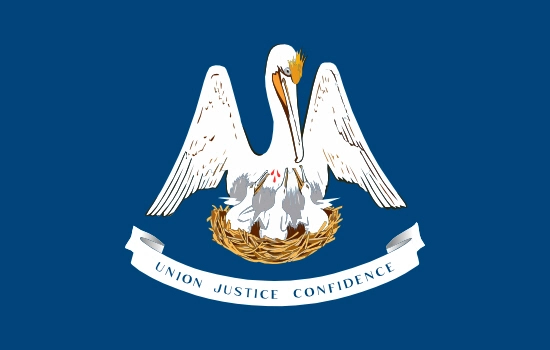
Nearby Labcorp Blood Testing facilities:
- Labcorp Center Distance: 0 m, 1716 Saint Charles Ave, New Orleans, Orleans Parish, LA, 70130
- Labcorp Center Distance: 4 m, 4520 Wichers Dr Ste 103, Marrero, Jefferson Parish, LA, 70072
- Labcorp Center Distance: 5 m, 120 Meadowcrest St, Gretna, Jefferson Parish, LA, 70056
- Labcorp Center Distance: 7 m, 4330 Loveland St Suite C, Metairie, Jefferson Parish, LA, 70006
- Labcorp Center Distance: 13 m, 3555 Loyola Dr Suite C, Kenner, Jefferson Parish, LA, 70065
- Labcorp Center Distance: 29 m, 700 Gause Blvd Ste 102, Slidell, St Tammany Parish, LA, 70458
- Labcorp Center Distance: 30 m, 105 Medical Center Drive 102A, Slidell, St Tammany Parish, LA, 70461
- Labcorp Center Distance: 35 m, 71380 Highway 21 Ste 102, Covington, St Tammany Parish, LA, 70433
- Labcorp Center Distance: 43 m, 1109 C M Fagan Drive Suite J, Hammond, Tangipahoa Parish, LA, 70403
- Labcorp Center Distance: 45 m, 826 School Street, Houma, Terrebonne Parish, LA, 70360
- Labcorp Center Distance: 54 m, 1124 S. Burnside Rd A-100, Gonzales, Ascension Parish, LA, 70737
- Labcorp Center Distance: 63 m, 1110 Broad Ave Ste 300, Gulfport, Harrison County, MS, 39501
- Labcorp Center Distance: 66 m, 11441 Industriplex Blvd Ste 140, Baton Rouge, East Baton Rouge Parish, LA, 70809
- Labcorp Center Distance: 69 m, 7922 Summa Ave. Ste. A-2, Baton Rouge, East Baton Rouge Parish, LA, 70809
- Labcorp Center Distance: 86 m, 1501 Hospital Ave, Franklin, St Mary Parish, LA, 70538
Nearby Quest Blood Testing facilities:
- Quest Center Distance: 2 m, 3525 Prytania Street, New Orleans, Orleans Parish, LA, 70115-3500
- Quest Center Distance: 3 m, 2600 Belle Chasse Hwy, Terrytown, Jefferson Parish, LA, 70056-7156
- Quest Center Distance: 4 m, 4700 Wichers Dr, Marrero, Jefferson Parish, LA, 70072-3023
- Quest Center Distance: 5 m, 6600 Franklin Ave, New Orleans, Orleans Parish, LA, 70122-5715
- Quest Center Distance: 7 m, 3908 Veterans Memorial Blvd, Metairie, Jefferson Parish, LA, 70002-5641
- Quest Center Distance: 13 m, 200 W Esplanade Ave, Kenner, Jefferson Parish, LA, 70065-2489
- Quest Center Distance: 28 m, 501 Rue De Sante, La Place, St John the Baptist Parish, LA, 70068-5404
- Quest Center Distance: 30 m, 2040 Gause Blvd E, Slidell, St Tammany Parish, LA, 70461-5453
- Quest Center Distance: 36 m, 706 W 15Th Ave, Covington, St Tammany Parish, LA, 70433-2416
- Quest Center Distance: 44 m, 1445 South Morrison Boulevard, Hammond, Tangipahoa Parish, LA, 70403-5705
- Quest Center Distance: 47 m, 1826 Martin Luther King Blvd, Houma, Terrebonne Parish, LA, 70360-2499
- Quest Center Distance: 67 m, 12207 Highway 49, Gulfport, Harrison County, MS, 39503-2955
- Quest Center Distance: 69 m, 7731 Perkins Road, Baton Rouge, East Baton Rouge Parish, LA, 70810-1080
New Orleans Hormone Replacement Therapy Services
Hormone Imbalance is one of the leading causes of physiological decline. Our hormones control how our bodies function, and make sure that all of our important systems are running in tandem with one another. At the Conscious Evolution Institute, we specialize is providing high quality Louisiana Hormone Replacement and Optimization services to help patients restore Hormone Balance and improve physiological function and quality of life.
We are a licensed and board-certified Hormone Clinic, and we are happy to provide our services to the New Orleans, Louisiana area. Our Hormone Specialists can find out if you qualify for Hormone Replacement with HGH or Testosterone, and we can also provide treatments like Bio-Identical HCG in order to help you establish a newer and healthier you. We have affiliate physicians all throughout New Orleans, as well as the greater New Orleans metropolitan area, that can meet with you at your leisure in order to provide the preliminary evaluation necessary to provide a clear and vivid picture of your Hormone Status. Call us today, or fill out the form on this page to make an appointment!
New Orleans Testosterone Replacement Clinic for Low-T Patients
As we learn more about the importance of Testosterone with regard to aging males, it becomes clear that Testosterone Deficiency is of great concern to men in New Orleans, not only for its effects upon sexual health, but its effects upon overall health and well-being. Low-T is associated with a number of very dangerous medical conditions, such as hypertension, stroke, diabetes, heart attack, obesity, Alzheimer's, and dementia. Men with healthy Testosterone Levels are at significantly lower risk for these conditions.
Erectile dysfunction and low libido are the two symptoms of Andropause and Testosterone Deficiency that are most recognizable, but there are many other symptoms of Louisiana Low-T, including weight gain, reduced confidence, anxiety, loss of strength, frailty, cognitive issues, loss of bone mineral density, and unhealthy cholesterol levels. Our New Orleans Testosterone Treatments with Low-T Patches, Topical Gels, and Intramuscular Injections (including Testosterone Cypionate and Enanthate) can help restore your Testosterone Balance and improve your health status as well as enhance your sexual performance and function.
New Orleans HGH Deficiency Treatments with Growth Hormone Injections
Another potentially life-changing Hormone Treatment that we offer is Human Growth Hormone Therapy. HGH is a powerful hormone which controls the rate at which the various cells in our bodies operate. Human Growth Hormone speeds up the body's processes, helping to keep us young, healthy, and in peak form. Early in life, HGH is responsible for encouraging growth and development, but, after we reach adulthood, Growth Hormone is still indispensible for its role in physiological maintenance.
Beyond the age of thirty, Human Growth Hormone Deficiency becomes more likely, as HGH Levels start to slowly decline. As a result of the importance of HGH, this decline can manifest a wide variety of symptoms, including, but not limited to, unhealthy changes in body composition, depression, fuzzy memory, inhibited healing, reduced physical capacity, atherosclerosis, reduced resistance to illness, diminished sex drive, and increased incidence of lines and wrinkles. New Orleans HGH Injection Therapy can reduce the appearance of these symptoms by boosting Growth Hormone Levels to those we enjoy during early adulthood.
New Orleans Sermorelin Therapy for Human Growth Hormone Optimization
Bio-Identical HGH Therapy is not the only Growth Hormone Replacement Treatment available to the citizens of New Orleans, Sermorelin Injections are just as, if not more effective, than Recombinant Growth Hormone at restoring normal HGH Levels in patients with Age-Associated Human Growth Hormone Deficiency. Sermorelin is the functional analog of an important Hormone made by the human body, known as Growth Hormone-Releasing Hormone, or GH-RH.
When Sermorelin is injected into the bloodstream, it stimulates the pituitary gland to release Human Growth Hormone as-needed for the body. Sermorelin is less expensive than Human Growth Hormone Therapy, and can be prescribed off-label, distinct advantages over Injectable HGH. New Orleans patients contact us today to learn more about Sermorelin!
New Orleans HCG Therapy Injections for Diet and Weight Loss
There are many Hormone Treatments that are not specifically designed to restore Hormone Balance, but to alter the body's function and composition in a way that encourages a healthier physiological state. HCG Injection Therapy is one of the tools at our disposal to help New Orleans HRT Patients reach a new and healthier shape. Bio-Identical HCG Treatments, when combined with a special, low-calorie diet, can promote fast weight loss for patients that are looking for a medically-facilitated weight loss program. Patients on HCG have experienced significant weight loss, rapidly, to the tune of thirty pounds in thirty days, all while maintaining healthy energy levels and avoiding the frustrating hunger and cravings related to similar diets!
New Orleans, Louisiana Information
New Orleans is one of the most popular tourist destinations in the United States, and draws visitors from all over the world on an annual basis. New Orleans is referred to by many names, including NOLA, Nawlins, The Big Easy, and the Crescent City. New Orleans is the most populous city in Louisiana, and is an indispensible American port city. The city is recognized for its huge French influence, and is named after a royal representative of Louis the Fifteenth known as the Duke of Orleans. New Orleans is also notable for its distinctive creole flair, a result of the multiculturalism established as a result of both its mixed heritage of Spanish and French as well as its cultural meld of African American, Native American, and Western culture.
There are two important universities located in New Orleans: Loyola and Tulane University. New Orleans has two professional sports teams that operate in the city, the New Orleans Saints of the NFL and the New Orleans Pelicans of the NBA. The most popular attraction in New Orleans is Bourbon Street, which is loaded with bars, dance clubs, and other entertainment locales which draw revelers not only during Mardi Gras and Jazz Fest, but all year round. New Orleans is surrounded by populous suburbs, including Jefferson, Elmwood, Harahan, River Ridge, Kenner, and Metairie.
All About New Orleans, Louisiana Geographic Area
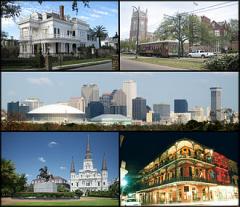
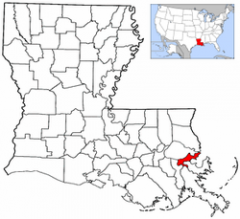
New Orleans ( /nuËa ËnÉerliÉonz/ or /ËnnuËa ÉerËnliËanz/, locally /nuËa ËnÉerlÉonz/ or /ËnnÉerlÉonz/; French: La Nouvelle-Orleans [la nuvÉolÉeÊaleÉaÌc] (
/nuËa ËnÉerliÉonz/ or /ËnnuËa ÉerËnliËanz/, locally /nuËa ËnÉerlÉonz/ or /ËnnÉerlÉonz/; French: La Nouvelle-Orleans [la nuvÉolÉeÊaleÉaÌc] ( listen)) is a major United States port and the largest city and metropolitan area in the state of Louisiana. The population of the city was 343,829 as of the 2010 U.S. Census. The New Orleans metropolitan area (New Orleans aeMetairie aeKenner Metropolitan Statistical Area) had a population of 1,167,764 in 2010 and was the 46th largest in the United States. The New Orleans aeMetairie aeBogalusa Combined Statistical Area, a larger trading area, had a 2010 population of 1,214,932.
listen)) is a major United States port and the largest city and metropolitan area in the state of Louisiana. The population of the city was 343,829 as of the 2010 U.S. Census. The New Orleans metropolitan area (New Orleans aeMetairie aeKenner Metropolitan Statistical Area) had a population of 1,167,764 in 2010 and was the 46th largest in the United States. The New Orleans aeMetairie aeBogalusa Combined Statistical Area, a larger trading area, had a 2010 population of 1,214,932.
The city is named after Orleans, a city located on the Loire River in Centre, France, and is well known for its distinct French Creole architecture, as well as its cross-cultural and multilingual heritage. New Orleans is also famous for its cuisine, music (particularly as the birthplace of jazz), and its annual celebrations and festivals, most notably Mardi Gras. The city is often referred to as the "most unique" in America.
New Orleans is located in southeastern Louisiana, straddling the Mississippi River. The boundaries of the city and Orleans Parish (French: paroisse d'Orleans) are coterminous. The city and parish are bounded by the parishes of St. Tammany to the north, St. Bernard to the east, Plaquemines to the south and Jefferson to the south and west. Lake Pontchartrain, part of which is included in the city limits, lies to the north and Lake Borgne lies to the east.
La Nouvelle-Orleans (New Orleans) was founded May 7, 1718, by the French Mississippi Company, under the direction of Jean-Baptiste Le Moyne de Bienville, on land inhabited by the Chitimacha. It was named for Philippe d'Orleans, Duke of Orleans, who was Regent of France at the time. His title came from the French city of Orleans. The French colony was ceded to the Spanish Empire in the Treaty of Paris (1763). During the American Revolutionary War, New Orleans was an important port to smuggle aid to the rebels, transporting military equipment and supplies up the Mississippi River. Bernardo de GR¡lvez y Madrid, Count of GR¡lvez successfully launched the southern campaign against the British from the city in 1779. New Orleans remained under Spanish control until 1801, when it reverted to French control. Nearly all of the surviving 18th century architecture of the Vieux Carre (French Quarter) dates from this Spanish period. (The most notable exception being the Old Ursuline Convent.) Napoleon sold the territory to the United States in the Louisiana Purchase in 1803. Thereafter, the city grew rapidly with influxes of Americans, French, Creoles, Irish, Germans and Africans. Major commodity crops of sugar and cotton were cultivated with slave labor on large plantations outside the city.
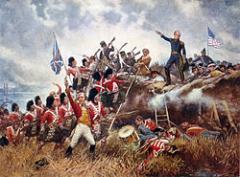
The Haitian Revolution of 1804 in what was then the French colony of St. Domingue established the second republic in the Western Hemisphere and the first led by blacks. Haitian refugees, both white and free people of color (affranchis or gens de couleur libres), arrived in New Orleans, often bringing African slaves with them. While Governor Claiborne and other officials wanted to keep out more free black men, French Creoles wanted to increase the French-speaking population. As more refugees were allowed in Louisiana, Haitian emigres who had gone to Cuba also arrived. Nearly 90 percent of the new immigrants settled in New Orleans. The 1809 migration brought 2,731 whites; 3,102 free persons of African descent; and 3,226 enslaved persons of African descent, doubling the city's French-speaking population. The city became 63 percent black in population, a greater proportion than Charleston, South Carolina's 53 percent. Many of these white francophones were deported by officials in Cuba in response to Bonapartist schemes in Spain.
During the last campaign of the War of 1812, the British sent a force of 11,000 soldiers in an attempt to capture New Orleans. Despite great challenges, the young Andrew Jackson successfully cobbled together a motley crew of local militia, free blacks, US Army regulars, Kentucky riflemen, and local privateers to decisively defeat the British troops, led by Sir Edward Pakenham, in the Battle of New Orleans on January 8, 1815. The armies were unaware that the Treaty of Ghent had already ended the war on December 24, 1814.
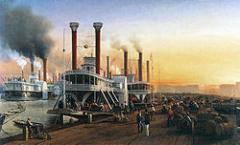
As a principal port, New Orleans played a major role during the antebellum era in the Atlantic slave trade. Its port handled huge quantities of commodities for export from the interior and imported goods from other countries, which were warehoused and then transferred in New Orleans to smaller vessels and distributed the length and breadth of the vast Mississippi River watershed. The river in front of the city was filled with steamboats, flatboats, and sailing ships. Despite its dealings with the slave trade, New Orleans at the same time had the largest and most prosperous community of free persons of color in the nation, who were often educated and middle-class property owners.
Dwarfing in population the other cities in the antebellum South, New Orleans had, consequently, the largest slave market. Two-thirds of the more than one million slaves brought to the Deep South arrived via the forced migration of the internal slave trade. The money generated by sales of slaves in the Upper South has been estimated at fifteen percent of the value of the staple crop economy. The slaves represented half a billion dollars in property, and an ancillary economy grew up around the trade in slaves aefor transportation, housing and clothing, fees, etc., estimated at 13.5 percent of the price per person. All of this amounted to tens of billions of dollars (2005 dollars, adjusted for inflation) during the antebellum period, with New Orleans as a prime beneficiary.
According to historian Paul Lachance, "the addition of white immigrants to the white creole population enabled French-speakers to remain a majority of the white population until almost 1830. If a substantial proportion of free persons of color and slaves had not also spoken French, however, the Gallic community would have become a minority of the total population as early as 1820." Large numbers of German and Irish immigrants began arriving at this time. The population of the city doubled in the 1830s and by 1840 New Orleans had become the wealthiest and third-most populous city in the nation.
The Union captured New Orleans early in the American Civil War, sparing the city the destruction suffered by many other cities of the American South.
In the 1850s white Francophones remained an intact and vibrant community, maintaining instruction in French in two of the city's four school districts. As the Creole elite feared, however, this changed with the Civil War; in 1862 French instruction in schools was abolished by Union general Ben Butler, and teaching of the language was forbidden in schools in 1868. By the end of the 19th century French usage in the city had faded significantly, although as late as 1945 one still encountered elderly Creole women who spoke no English.
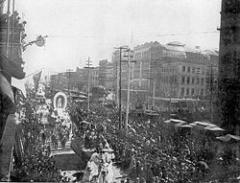
During Reconstruction New Orleans was within the Fifth Military District of the United States. Louisiana was readmitted to the Union in 1868, and its Constitution of 1868 granted universal manhood suffrage. Due to the state's large African American population, many blacks held public office. In 1872, then-lieutenant governor P.B.S. Pinchback succeeded Henry Clay Warmouth as governor of Louisiana, becoming the first non-white governor of a U.S. state, and the last African American to lead a U.S. state until Douglas Wilder's election in Virginia, 117 years later. In New Orleans, Reconstruction was marked by the horrible Mechanics Institute race riot (1866) but also by the successful operation of a fully racially-integrated public school system. Meanwhile, the city's economy struggled to right itself after practically grinding to a halt upon the declaration of war in 1861, the nationwide Panic of 1873 conspiring to severely retard economic recovery.
Reconstruction ended in Louisiana in 1877, and white southern Democrats, the so-called Redeemers, succeeded in stripping power from the Republican Party and gradually circumscribing the only recently acquired civil rights of African Americans. In New Orleans, the public schools were resegregated and remained so until 1960.
New Orleans' large community of well-educated, often French-speaking free persons of color (gens de couleur libres), who had not been enslaved prior to the Civil War, sought to fight back against the incipient forces of Jim Crow. As part of their ongoing campaign, they recruited one of their own, Homer Plessy, to test whether Louisiana's newly enacted Separate Car Act was constitutional. Plessy duly boarded a commuter train departing New Orleans for Covington, Louisiana, sat in the car reserved for whites only and was arrested. The case spawned by this incident, Plessy v. Ferguson, was heard by the U.S. Supreme Court in 1896. The court, in finding that "separate but equal" accommodations were constitutional, strengthened by effectively consecrating the already-underway Jim Crow movement. The ruling was a key development in the nadir of race relations reached during this period.
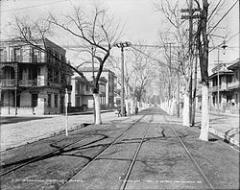
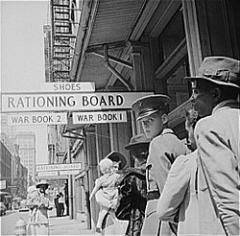
New Orleans reached its most consequential position as an economic and population center in relation to other American cities in the decades prior to 1860; as late as that year it was the nation's fifth-largest city and by far the largest in the American South. Though New Orleans continued to grow in size, from the mid-19th century onwards, first the emerging industrial and railroad hubs of the Midwest overtook the city in population, then the rapidly growing metropolises of the Pacific Coast in the decades before and after the turn of the 20th century, then other Sun Belt cities in the South and West in the post aeWorld War II period surpassed New Orleans in population. From the late 1800s, most 10-year censuses depicted New Orleans sliding down the list of largest American cities. Thus reminded every ten years of its declining relative importance, New Orleans would periodically mount attempts to regain its economic vigor and pre-eminence, with varying degrees of success. In 1950, the Census Bureau reported New Orleans' population as 68% white and 31.9% black.
By the mid-20th century, New Orleanians were observing with concern that the city was even ceding its traditional ranking as the leading urban area in the South. By 1950, Houston, Dallas and Atlanta had surpassed New Orleans in size, and 1960 witnessed Miami's eclipse of New Orleans, even as New Orleans' population was recorded as reaching its historic peak by the 1960 Census. Like most older American cities in this period, New Orleans' city center commenced losing inhabitants, though the New Orleans metropolitan area continued expanding in population ae just never as rapidly as its metropolitan peers in the Sun Belt. While the port remained one of the largest in the nation, automation and containerization resulted in significant job losses. The city's relative fall in stature meant that its former role as banker to the South was inexorably supplanted by competing companies in its now-larger peer cities. New Orleans' economy had always been more based on trade and financial services than on manufacturing, but the city's relatively small manufacturing sector also shrank in the post aeWorld War II period. Despite some economic development successes under the administrations of DeLesseps "Chep" Morrison (1946 ae1961) and Vic Schiro (1961 ae1970), metropolitan New Orleans' growth rate consistently lagged behind the more vigorous Sun Belt cities.
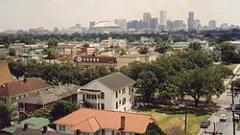
During the later years of Morrison's administration, and for the entirety of Schiro's, the city struggled to digest the ramifications of the legal enfranchisement of its sizable African-American population. New Orleans was very much at the center of the Civil Rights struggle. The Southern Christian Leadership Conference was founded in the city, lunch counter sit-ins were held in Canal Street stores, and a very prominent and violent series of confrontations occurred when the city attempted school desegregation, in 1960. That episode witnessed the first occasion of a black child attending an all-white elementary school in the South, when six-year-old Ruby Bridges integrated William Frantz Elementary School in the city's Ninth Ward. The Civil Rights Movement's success in realizing the desegregation of public facilities and schools, and the enfranchisement of the black voter, constituted the most significant event in New Orleans' 20th century history. Though legal equality was established by the end of the 1960s, a large gap in income levels and educational attainment persisted between the city's White and African American communities. The effects of this gap were amplified by accelerating white flight, as the city's population grew poorer and more African American. New Orleans' political leadership, from 1980 onwards firmly in the hands of its African-American majority, struggled to narrow this gap by creating conditions conducive to the economic uplift of the African American community.
New Orleans became increasingly dependent on tourism as an economic mainstay, arguably fatally so by the administrations of Sidney Barthelemy (1986 ae1994) and Marc Morial (1994 ae2002). Relatively low levels of educational attainment, high rates of household poverty and rising crime became increasingly problematic in the later decades of the century, with the negative effects of these socioeconomic conditions newly amplified as the United States economy increasingly rested upon a post-industrial, knowledge-based paradigm where brains were far more important than brawn.
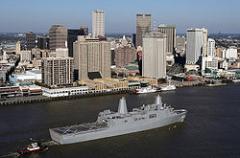
The turn of the 20th century witnessed one of the earlier episodes in the ongoing series of energetic recommitments to jump-starting economic growth on the part of New Orleans' government and business leaders. The most ambitious development during this period was a drainage plan devised by engineer and inventor A. Baldwin Wood and designed to break the surrounding swamp's stranglehold on the city's geographic expansion. Until then, urban development in New Orleans was largely limited to higher ground along the natural river levees and bayous. Wood's pump system allowed the city to drain huge tracts of swamp and marshland and expand into low-lying areas. Over the 20th century, rapid subsidence, both natural and human-induced, left these newly populated areas several feet below sea level.
New Orleans was vulnerable to flooding even before the city's footprint departed from the natural high ground near the Mississippi River. In the late 20th century, however, scientists and New Orleans residents gradually became aware of the city's increased vulnerability. In 1965, Hurricane Betsy killed dozens of residents, even though the majority of the city remained dry. The rain-induced flood of May 8, 1995 demonstrated the weakness of the pumping system. After that event, measures were undertaken to dramatically upgrade pumping capacity. By the 1980s and 1990s, it was worrisomely clear that extensive, rapid and ongoing erosion of the marshlands and swamp surrounding New Orleans, especially that related to the Mississippi River ae Gulf Outlet Canal, had left the city far more exposed to hurricane-induced catastrophic storm surges than it had ever before been in its history.
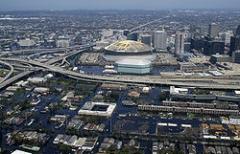
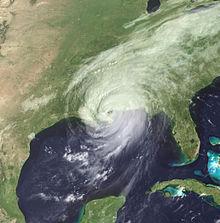
New Orleans was catastrophically impacted by what the University of California Berkeley's Dr. Raymond B. Seed called "the worst engineering disaster in the world since Chernobyl" when the Federal levee system failed during Hurricane Katrina in 2005. By the time the hurricane approached the city at the end of August 2005, most residents had evacuated. As the hurricane passed through the Gulf Coast region, the city's federal flood protection system failed, resulting in the worst civil engineering disaster in American history. Floodwalls and levees constructed by the United States Army Corps of Engineers failed below design specifications and 80% of the city flooded. Tens of thousands of residents who had remained in the city were rescued or otherwise made their way to shelters of last resort at the Louisiana Superdome or the New Orleans Morial Convention Center. Over 1,500 people died in Louisiana and some are still unaccounted for. Hurricane Katrina called for the first mandatory evacuation in the city's history, the second of which came 3 years later with Hurricane Gustav.
The city was declared off-limits to residents while efforts to clean up after Hurricane Katrina began. The approach of Hurricane Rita in September 2005 caused repopulation efforts to be postponed, and the Lower Ninth Ward was reflooded by Rita's storm surge.
The Census Bureau in July 2006 estimated the population of New Orleans to be 223,000; a subsequent study estimated that 32,000 additional residents had moved to the city as of March 2007, bringing the estimated population to 255,000, approximately 56% of the pre-Katrina population level. Another estimate, based on data on utility usage from July 2007, estimated the population to be approximately 274,000 or 60% of the pre-Katrina population. These estimates are somewhat smaller than a third estimate, based on mail delivery records, from the Greater New Orleans Community Data Center in June 2007, which indicated that the city had regained approximately two-thirds of its pre-Katrina population. In 2008, the Census Bureau revised upward its population estimate for the city, to 336,644. Most recently, 2010 estimates show that neighborhoods that did not flood are near 100% of their pre-Katrina populations, and in some cases, exceed 100% of their pre-Katrina populations.
Several major tourist events and other forms of revenue for the city have returned. Large conventions are being held again, such as those held by the American Library Association and American College of Cardiology. College football events such as the Bayou Classic, New Orleans Bowl, and Sugar Bowl returned for the 2006 ae2007 season. The New Orleans Saints returned that season as well, following speculation of a move. The New Orleans Hornets returned to the city fully for the 2007 ae2008 season, having partially spent the 2006 ae2007 season in Oklahoma City. New Orleans successfully hosted the 2008 NBA All-Star Game and the 2008 BCS National Championship Game. The city hosted the first and second rounds of the 2007 NCAA Men's Division I Basketball Tournament. New Orleans and Tulane University will be hosting the Final Four Championship in 2012. Additionally, the city will host Super Bowl XLVII on February 3, 2013 at the Mercedes-Benz Superdome.
Major annual events such as Mardi Gras and the Jazz & Heritage Festival were never displaced or cancelled. Also, an entirely new annual festival, "The Running of the Bulls New Orleans", was created in 2007.
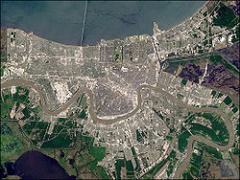
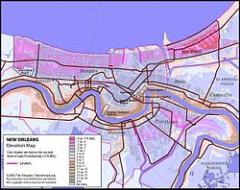
New Orleans is located at 29 °57 a²53 a³N 90 °4 a²14 a³W / 29.96472 °N 90.07056 °W / 29.96472; -90.07056 (29.964722, na90.070556) on the banks of the Mississippi River, approximately 105 miles (169 km) upriver from the Gulf of Mexico. According to the United States Census Bureau, the city has a total area of 350.2 square miles (907 km2), of which 180.56 square miles (467.6 km2), or 51.55%, is land.
The city is located in the Mississippi River Delta on the east and west banks of the Mississippi River and south of Lake Pontchartrain. The area along the river is characterized by ridges and hollows.
New Orleans was originally settled on the natural levees or high ground, along the Mississippi River. After the Flood Control Act of 1965, the United States Army Corps of Engineers built floodwalls and man-made levees around a much larger geographic footprint that included previous marshland and swamp. Whether or not this human interference has caused subsidence is a topic of debate. A study by an associate professor at Tulane University claims:
On the other hand, a report by the American Society of Civil Engineers claims that "New Orleans is subsiding (sinking)":
A recent study by Tulane and Xavier University notes that 51% of New Orleans is at or above sea level, with the more densely populated areas generally on higher ground. The average elevation of the city is currently between one and two feet (0.5 m) below sea level, with some portions of the city as high as 20 feet (6 m) at the base of the river levee in Uptown and others as low as 7 feet (2 m) below sea level in the farthest reaches of Eastern New Orleans.
In 2005, storm surge from Hurricane Katrina caused catastrophic failure of the federally designed and built levees, flooding 80% of the city. A report by the American Society of Civil Engineers says that "had the levees and floodwalls not failed and had the pump stations operated, nearly two-thirds of the deaths would not have occurred".
New Orleans has always had to consider the risk of hurricanes, but the risks are dramatically greater today due to coastal erosion from human interference. Since the beginning of the 20th century, it has been estimated that Louisiana has lost 2,000 square miles (5,000 km2) of coast (including many of its barrier islands), which once protected New Orleans against storm surge. Following Hurricane Katrina, the United States Army Corps of Engineers has instituted massive levee repair and hurricane protection measures to protect the city.
In 2006, Louisiana voters overwhelmingly adopted an amendment to the state's constitution to dedicate all revenues from off-shore drilling to restore Louisiana's eroding coast line. Congress has allocated $7 billion to bolster New Orleans' flood protection.
According to a study by the National Academy of Engineering and the National Research Council, Levees and floodwalls surrounding New Orleans aeno matter how large or sturdy aecannot provide absolute protection against overtopping or failure in extreme events. Levees and floodwalls should be viewed as a way to reduce risks from hurricanes and storm surges, not as measures that completely eliminate risk. For structures in hazardous areas and residents who do not relocate, the committee recommended major floodproofing measures aesuch as elevating the first floor of buildings to at least the 100-year flood level.
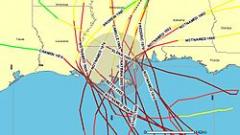
The climate of New Orleans is humid subtropical (Koppen climate classification Cfa), with short, generally mild winters and hot, humid summers. In January, morning lows average around 43 °F (6 °C), and daily highs around 62 °F (17 °C). In July, lows average 74 °F (23 °C), and highs average 91 °F (33 °C). The lowest recorded temperature was 7 °F ( na14 °C) on February 13, 1899. The highest recorded temperature was 102 °F (39 °C) on August 22, 1980. The average precipitation is 64.2 inches (1,630 mm) annually; the summer months are the wettest, while October is the driest month. Precipitation in winter usually accompanies the passing of a cold front.
Hurricanes pose a severe threat to the area, and the city is particularly at risk because of its low elevation, and because it is surrounded by water from the north, east, and south, and Louisiana's sinking coast. According to the Federal Emergency Management Agency, New Orleans is the nation's most vulnerable city to hurricanes. Indeed, portions of Greater New Orleans have been flooded by: the Grand Isle Hurricane of 1909, the New Orleans Hurricane of 1915, 1947 Fort Lauderdale Hurricane, Hurricane Flossy in 1956, Hurricane Betsy in 1965, Hurricane Georges in 1998, Hurricane Katrina in 2005, Hurricane Rita in 2005, and Hurricane Gustav in 2008, with the flooding in Betsy being significant and in a few neighborhoods severe, and that in Katrina being disastrous in the majority of the city.
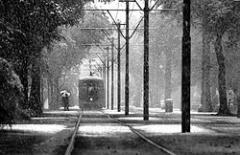
New Orleans experiences snowfall only on rare occasions. A small amount of snow fell during the 2004 Christmas Eve Snowstorm and again on Christmas (December 25) when a combination of rain, sleet, and snow fell on the city, leaving some bridges icy. Before that, the last White Christmas was in 1964 and brought 4.5 inches (11 cm). Snow fell again on December 22, 1989, when most of the city received 1 ae2 inches (2.5 ae5.1 cm).
The last significant snow fall in New Orleans was on the morning of December 11, 2008.

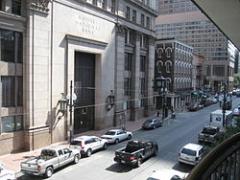
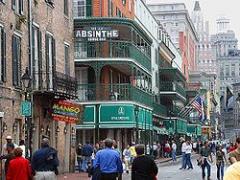
The Central Business District of New Orleans is located immediately north and west of the Mississippi River, and was historically called the "American Quarter" or "American Sector", and it includes Lafayette Square. Most streets in this area fan out from a central point in the city. Major streets of the area include Canal Street, Poydras Street, Tulane Avenue and Loyola Avenue. Canal Street functions as the street which divides the traditional "downtown" area from the "uptown" area.
Every street crossing Canal Street between the Mississippi River and Rampart Street, which is the northern edge of the French Quarter, has a different name for the "uptown" and "downtown" portions. For example, St. Charles Avenue, known for its street car line, is called Royal Street below Canal Street, though where it traverses the Central Business District between Canal and Lee Circle, it is properly called St. Charles Street. Elsewhere in the city, Canal Street serves as the dividing point between the "South" and "North" portions of various streets. In the local parlance downtown means "downriver from Canal Street", while uptown means "upriver from Canal Street". Downtown neighborhoods include the French Quarter, Treme, the 7th Ward, Faubourg Marigny, Bywater (the Upper Ninth Ward), and the Lower Ninth Ward. Uptown neighborhoods include the Warehouse District, the Lower Garden District, the Garden District, the Irish Channel, the University District, Carrollton, Gert Town, Fontainebleau, and Broadmoor. However, the Warehouse and the Central Business District, despite being above Canal Street, are frequently called "Downtown" as a specific region, as in the Downtown Development District.
Other major districts within the city include Bayou St. John, Mid-City, Gentilly, Lakeview, Lakefront, New Orleans East, and Algiers.
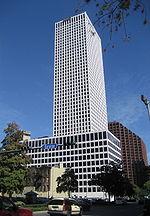
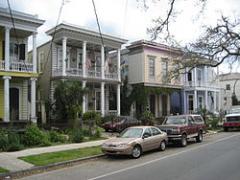
New Orleans is world-famous for its abundance of unique architectural styles which reflect the city's historical roots and multicultural heritage. Though New Orleans possesses numerous structures of national architectural significance, it is equally, if not more, revered for its enormous, largely intact (even post-Katrina) historic built environment. Twenty National Register Historic Districts have been established, and fourteen local historic districts aid in the preservation of this tout ensemble. Thirteen of the local historic districts are administered by the New Orleans Historic District Landmarks Commission (HDLC), while one aethe French Quarter aeis administered by the Vieux Carre Commission (VCC). Additionally, both the National Park Service, via the National Register of Historic Places, and the HDLC have landmarked individual buildings, many of which lie outside the boundaries of existing historic districts.
Many styles of housing exist in the city, including the shotgun house (originating from New Orleans) and the bungalow style. Creole townhouses, notable for their large courtyards and intricate iron balconies, line the streets of the French Quarter. Throughout the city, there are many other historic housing styles: Creole cottages, American townhouses, double-gallery houses, and Raised Center-Hall Cottages. St. Charles Avenue is famed for its large antebellum homes. Its mansions are in various styles, such as Greek Revival, American Colonial and the Victorian styles of Queen Anne and Italianate architecture. New Orleans is also noted for its large, European-style Catholic cemeteries, which can be found throughout the city.
For much of its history, New Orleans' skyline consisted of only low- and mid-rise structures. The soft soils of New Orleans are susceptible to subsidence, and there was doubt about the feasibility of constructing large high rises in such an environment. The 1960s brought the World Trade Center New Orleans and Plaza Tower, which demonstrated that high rises could stand firm on New Orleans' soil. One Shell Square took its place as the city's tallest building in 1972. The oil boom of the early 1980s redefined New Orleans' skyline again with the development of the Poydras Street corridor. Today, New Orleans' high rises are clustered along Canal Street and Poydras Street in the Central Business District.
New Orleans has many major attractions, from the world-renowned French Quarter and Bourbon Street's notorious nightlife to St. Charles Avenue (home of Tulane and Loyola Universities, the historic Pontchartrain Hotel, and many 19th century mansions), to Magazine Street, with its many boutique stores and antique shops.
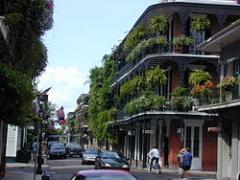
According to current travel guides, New Orleans is one of the top ten most visited cities in the United States; 10.1 million visitors came to New Orleans in 2004, and the city was on pace to break that level of visitation in 2005. Prior to Katrina, there were 265 hotels with 38,338 rooms in the Greater New Orleans Area. In May 2007, there were over 140 hotels and motels in operation with over 31,000 rooms.
A 2009 Travel + Leisure poll of "America's Favorite Cities" ranked New Orleans first in ten categories, the most first-place rankings of the 30 cities included. According to the poll, New Orleans is the best U.S. city as a spring break destination and for "wild weekends", stylish boutique hotels, cocktail hours, singles/bar scenes, live music/concerts and bands, antique and vintage shops, cafes/coffee bars, neighborhood restaurants, and people watching. The city also ranked second for gay friendliness (behind San Francisco, California), friendliness (behind Charleston, South Carolina), bed and bath hotels and inns, and ethnic food. However the city was voted last in terms of active residents and near the bottom in cleanliness, safety, and as a family destination.
The French Quarter (known locally as "the Quarter" or Vieux Carre), which dates from the French and Spanish eras and is bounded by the Mississippi River, Rampart Street, Canal Street, and Esplanade Avenue, contains many popular hotels, bars, and nightclubs. Notable tourist attractions in the Quarter include Bourbon Street, Jackson Square, St. Louis Cathedral, the French Market (including Cafe du Monde, famous for cafe au lait and beignets) and Preservation Hall. To tour the port, one can ride the Natchez, an authentic steamboat with a calliope, which cruises the Mississippi the length of the city twice daily. Unlike most other places in The United States, and the world, New Orleans has become widely known for its element of elegant decay. The city's many beautiful cemeteries and their distinct above-ground tombs are often attractions in themselves, the oldest and most famous of which, Saint Louis Cemetery, greatly resembles Pere Lachaise Cemetery in Paris.
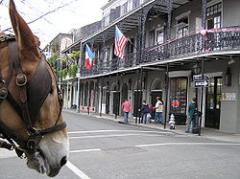
Also located in the French Quarter is the old New Orleans Mint, a former branch of the United States Mint, which now operates as a museum, and The Historic New Orleans Collection, a museum and research center housing art and artifacts relating to the history of New Orleans and the Gulf South. The National World War II Museum, opened in the Warehouse District in 2000 as the "National D-Day Museum", is dedicated to providing information and materials related to the Invasion of Normandy. Nearby, Confederate Memorial Hall, the oldest continually operating museum in Louisiana (although under renovation since Katrina), contains the second-largest collection of Confederate memorabilia in the world. Art museums in the city include the Contemporary Arts Center, the New Orleans Museum of Art (NOMA) in City Park, and the Ogden Museum of Southern Art.
New Orleans also boasts a decidedly natural side. It is home to the Audubon Nature Institute (which consists of Audubon Park, the Audubon Zoo, the Aquarium of the Americas, and the Audubon Insectarium), as well as gardens that include Longue Vue House and Gardens and the New Orleans Botanical Garden. City Park, one of the country's most expansive and visited urban parks, has one of the largest (if not the largest) stands of oak trees in the world.
There are also various points of interest in the surrounding areas. Many wetlands are in close proximity to the city, including Honey Island Swamp. Chalmette Battlefield and National Cemetery, located just south of the city, is the site of the 1815 Battle of New Orleans.
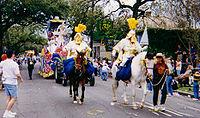
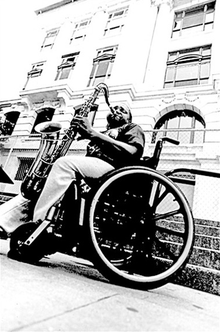
The New Orleans area is home to numerous celebrations, the most popular of which is Carnival, often referred to as Mardi Gras. Carnival officially begins on the Feast of the Epiphany, also known as the "Twelfth Night". Mardi Gras (French for "Fat Tuesday"), the final and grandest day of festivities, is the last Tuesday before the Catholic liturgical season of Lent, which commences on Ash Wednesday.
The largest of the city's many music festivals is the New Orleans Jazz & Heritage Festival. Commonly referred to simply as "Jazz Fest", it is one of the largest music festivals in the nation, featuring crowds of people from all over the world, coming to experience music, food, arts, and crafts. Despite the name, it features not only jazz but a large variety of music, including both native Louisiana music and international artists. Along with Jazz Fest, New Orleans' Voodoo Experience ("Voodoo Fest") and the Essence Music Festival are both large music festivals featuring local and international artists.
Other major festivals held in the city include Southern Decadence, the French Quarter Festival, and the Tennessee Williams/ New Orleans Literary Festival.
In 2002, Louisiana began offering tax incentives for film and television production. This led to a substantial increase in the number of films shot in the New Orleans area and brought the nickname "Hollywood South." Films which have been filmed or produced in and around New Orleans include: Ray, Runaway Jury, The Pelican Brief, Glory Road, All the King's Men, DejRr Vu, Last Holiday, The Curious Case of Benjamin Button, and numerous others. In 2006, work began on the Louisiana Film & Television studio complex, based in the Treme neighborhood. Louisiana began to offer similar tax incentives for music and theater productions in 2007, leading many to begin referring to New Orleans as "Broadway South."
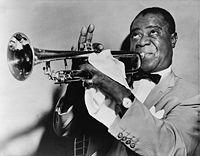
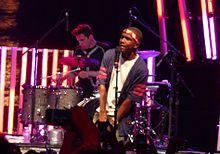
New Orleans has always been a significant center for music, showcasing its intertwined European, Latin American, and African cultures. New Orleans' unique musical heritage was born in its pre-American and early American days from a unique blending of European instruments with African rhythms. As the only North American city to allow slaves to gather in public and play their native music (largely in Congo Square, now located within Louis Armstrong Park), New Orleans gave birth to an indigenous music: jazz. Soon, brass bands formed, gaining popular attraction that still holds today. The city's music was later significantly influenced by Acadiana, home of Cajun and Zydeco music, and Delta blues.
New Orleans' unique musical culture is further evident in its funerals. A spin on the tradition of military brass band funerals, traditional New Orleans funerals feature sad music (mostly dirges and hymns) on the way to the cemetery and happier music (hot jazz) on the way back. Such traditional musical funerals still take place when a local musician, a member of a club, krewe, or benevolent society, or a noted dignitary has passed. Until the 1990s, most locals preferred to call these "funerals with music", but visitors to the city have long dubbed them "jazz funerals".
Much later in its musical development, New Orleans was home to a distinctive brand of rhythm and blues that contributed greatly to the growth of rock and roll. An example of the New Orleans' sound in the 1960s is the #1 US hit "Chapel of Love" by the Dixie Cups, a song which knocked The Beatles out of the top spot on the Billboard Hot 100. New Orleans became a hotbed for funk music in the 1960s and 1970s, and by the late 1980s, it had developed its own localized variant of hip hop, called bounce music. While never commercially successful outside of the Deep South, it remained immensely popular in the poorer neighborhoods of the city throughout the 1990s.
A cousin of bounce, New Orleans hip hop has seen commercial success locally and internationally, producing Lil Wayne, Master P, Birdman, Juvenile, Cash Money Records, and No Limit Records. Additionally, the wave of popularity of cowpunk, a fast form of southern rock, originated with the help of several local bands, such as The Radiators, Better Than Ezra, Cowboy Mouth, and Dash Rip Rock. Throughout the 1990s, many sludge metal bands started in the area. New Orleans' heavy metal bands like Eyehategod, Soilent Green, Crowbar, and Down have incorporated styles such as hardcore punk, doom metal, and southern rock to create an original and heady brew of swampy and aggravated metal that has largely avoided standardization.
New Orleans is the southern terminus of the famed Highway 61.
The major daily newspaper is The Times-Picayune, publishing since 1837. Weekly publications include The Louisiana Weekly and Gambit Weekly. Also in wide circulation is the Clarion Herald, the newspaper of the Archdiocese of New Orleans.
Greater New Orleans is the 54th largest Designated Market Area (DMA) in the U.S., serving 566,960 homes. Major television network affiliates serving the area include:
Two radio stations that were influential in promoting New Orleans-based bands and singers were 50,000-watt WNOE-AM (1060) and 10,000-watt WTIX-AM (690). These two stations competed head-to-head from the late 1950s to the late 1970s.
WWOZ, the New Orleans Jazz and Heritage Station, broadcasts, 24 hours per day, modern and traditional jazz, blues, rhythm and blues, brass band, gospel, cajun, zydeco, Caribbean, Latin, Brazilian, African, bluegrass, and Irish at 90.7 FM and at http://www.wwoz.org.
WTUL, a local college radio station (Tulane University), broadcasts a wide array of programming, including 20th century classical, reggae, jazz, showtunes, indie rock, electronic music, soul/funk, goth, punk, hip hop, New Orleans music, opera, folk, hardcore, Americana, country, blues, Latin, cheese, techno, local, world, ska, swing and big band, kids shows, and even news programming from DemocracyNow. WTUL is listener supported and non-commercial. The disc jockeys are volunteers, many of them college students.
Louisiana's film and television tax credits have spurred some growth in the television industry, although to a lesser degree than in the film industry. Many films and advertisements have in part or whole been filmed in the city, as have television programs such as The Real World: New Orleans in 2000, The Real World: Back to New Orleans in 2009 and 2010 and Bad Girls Club: New Orleans in 2011.
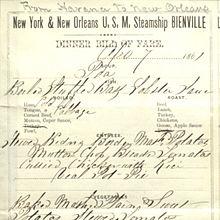
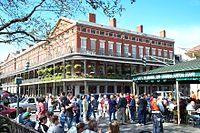
New Orleans is world-famous for its food. The indigenous cuisine is distinctive and influential. From centuries of amalgamation of the local Creole, haute Creole, and New Orleans French cuisines, New Orleans food has developed. Local ingredients, French, Spanish, Italian, African, Native American, Cajun, Chinese, and a hint of Cuban traditions combine to produce a truly unique and easily recognizable Louisiana flavor.
New Orleans is known for specialties like beignets (locally pronounced like "ben-yays"), square-shaped fried pastries that could be called "French doughnuts" (served with cafe au lait made with a blend of coffee and chicory rather than only coffee); and Po' boy and Italian Muffuletta sandwiches; Gulf oysters on the half-shell, fried oysters, boiled crawfish, and other seafood; etouffee, jambalaya, gumbo, and other Creole dishes; and the Monday favorite of red beans and rice. (Louis Armstrong often signed his letters, "Red beans and ricely yours".) Another New Orleans specialty is the Praline local /ËnprÉaËaliËan/, a candy made with brown sugar, granulated sugar, cream, butter, and pecans. The city also has notable street food including the Asian inspired beef Yaka mein.
New Orleans has developed a distinctive local dialect of American English over the years that is neither Cajun nor the stereotypical Southern accent, so often misportrayed by film and television actors. It does, like earlier Southern Englishes, feature frequent deletion of the post-vocalic "r". This dialect is quite similar to New York City area accents such as "Brooklynese", to people unfamiliar with either. There are many theories regarding how it came to be, but it likely resulted from New Orleans' geographic isolation by water and the fact that the city was a major immigration port throughout the 19th century. As a result, many of the ethnic groups who reside in Brooklyn also reside in New Orleans, such as the Irish, Italians (especially Sicilians), and Germans, among others, as well as a very sizable Jewish community.
One of the strongest varieties of the New Orleans accent is sometimes identified as the Yat dialect, from the greeting "Where y'at?" This distinctive accent is dying out generation by generation in the city itself, but remains very strong in the surrounding parishes.
Less visibly, various ethnic groups throughout the area have retained their distinctive language traditions to this day. Although rare, Kreyol Lwiziyen is still spoken by the Creoles. Also rare, an archaic Louisiana-Canarian Spanish dialect is spoken by the IsleR±o people, but it can usually only be heard by older members of the population.
New Orleans' professional sports teams include the 2009 Super Bowl champion New Orleans Saints (NFL), the New Orleans Hornets (NBA), the New Orleans Zephyrs (PCL), and returning for the 2011 season, the New Orleans VooDoo (AFL). It is also home to the Big Easy Rollergirls, an all-female flat track roller derby team, and the New Orleans Blaze, a women's football team. A local group of investors began conducting a study in 2007 to see if the city could support a Major League Soccer team.
The Louisiana Superdome is the home of the Saints, the Sugar Bowl, and other prominent events. It has hosted the Super Bowl a record six times (1978, 1981, 1986, 1990, 1997, 2002) and will host again in 2013. The New Orleans Arena is the home of the Hornets, VooDoo, and many events that are not large enough to need the Superdome. New Orleans is also home to the Fair Grounds Race Course, the nation's third-oldest thoroughbred track. The city's Lakefront Arena has also been home to sporting events.
Each year New Orleans plays host to the Sugar Bowl, the New Orleans Bowl and the Zurich Classic, a golf tournament on the PGA Tour. In addition, it has often hosted major sporting events that have no permanent home, such as the Super Bowl, ArenaBowl, NBA All-Star Game, BCS National Championship Game, and the NCAA Final Four. The Rock adn ao Roll Mardi Gras Marathon and the Crescent City Classic are two road running events held annually in the city.
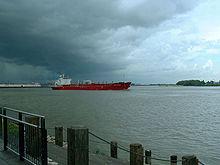
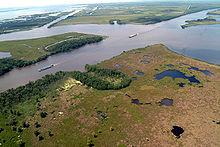
New Orleans is home to one of the largest and busiest ports in the world, and metropolitan New Orleans is a center of maritime industry. The New Orleans region also accounts for a significant portion of the nation's oil refining and petrochemical production, and serves as a white collar corporate base for onshore and offshore petroleum and natural gas production. New Orleans is a center for higher learning, with over 50,000 students enrolled in the region's eleven two- and four-year degree granting institutions. A top 50 research university, Tulane University, is located in New Orleans' Uptown neighborhood. Metropolitan New Orleans is a major regional hub for the health care industry and boasts a small, globally competitive manufacturing sector. The center city possesses a rapidly growing, entrepreneurial creative industries sector, and is, of course, renowned for its cultural tourism. Greater New Orleans, Inc. (GNO, Inc.) acts as the first point-of-contact for regional economic development and is slotted between Louisiana's Department of Economic Development and the various parochial business development agencies.
New Orleans came into being to act as a strategically located trading entrepot, and it remains, above all, a crucial transportation hub and distribution center for waterborne commerce. The Port of New Orleans is the 5th-largest port in the United States based on volume of cargo handled, second-largest in the state after the Port of South Louisiana, and 12th-largest in the U.S., based on value of cargo. The Port of South Louisiana, also based in the New Orleans area, is the world's busiest in terms of bulk tonnage and, when combined with the Port of New Orleans, it forms the 4th-largest port system in volume handled. Many shipbuilding, shipping, logistics, freight forwarding and commodity brokerage firms either call metropolitan New Orleans home or maintain a large local presence. Examples include Intermarine, Bisso Towboat, Northrop Grumman Ship Systems, Trinity Yachts, Expeditors International, Bollinger Shipyards, IMTT, International Coffee Corp, Boasso America, Transoceanic Shipping, Transportation Consultants Inc., Dupuy Storage & Forwarding and Silocaf. The largest coffee-roasting plant in the world, operated by Folgers, is located in New Orleans East.
Like Houston, New Orleans is located in proximity to the Gulf of Mexico and the many oil rigs that lie just offshore. Louisiana ranks fifth in oil production and eighth in reserves in the United States. It is also home to two of the four Strategic Petroleum Reserve (SPR) storage facilities: West Hackberry in Cameron Parish and Bayou Choctaw in Iberville Parish. Other infrastructure includes 17 petroleum refineries with a combined crude oil distillation capacity of nearly 2.8 million barrels per day (450,000 m3/d), the second highest in the nation after Texas. Louisiana's numerous ports include the Louisiana Offshore Oil Port (LOOP), which is capable of receiving ultra large oil tankers. Given the quantity of oil importing, Louisiana is home to many major pipelines supplying the nation: Crude Oil (Exxon, Chevron, BP, Texaco, Shell, Scurloch-Permian, Mid-Valley, Calumet, Conoco, Koch Industries, Unocal, U.S. Dept. of Energy, Locap); Product (TEPPCO Partners, Colonial, Plantation, Explorer, Texaco, Collins); and Liquefied Petroleum Gas (Dixie, TEPPCO, Black Lake, Koch, Chevron, Dynegy, Kinder Morgan Energy Partners, Dow Chemical Company, Bridgeline, FMP, Tejas, Texaco, UTP). Several major energy companies have regional headquarters in the city or its suburbs, including Royal Dutch Shell, Eni and Chevron. Numerous other energy producers and oilfield services companies are also headquartered in the city or region, and the sector supports a large professional services base of specialized engineering and design firms, as well as an office for the federal government's Minerals Management Service.
The city is the home to a single Fortune 500 company: Entergy, a power generation utility and nuclear powerplant operations specialist. In the wake of Hurricane Katrina, the city lost its other Fortune 500 company, Freeport-McMoRan, when it merged its copper and gold exploration unit with an Arizona company and relocated that division to Phoenix, Arizona. Its McMoRan Exploration affiliate remains headquartered in New Orleans. Other companies either headquartered or with significant operations in New Orleans include: Pan American Life Insurance, Pool Corp, Rolls-Royce, Newpark Resources, AT&T, TurboSquid, iSeatz, IBM, Navtech, Superior Energy Services, Textron Marine & Land Systems, McDermott International, Pellerin Milnor, Lockheed Martin, Imperial Trading, Laitram, Harrah's Entertainment, Stewart Enterprises, Edison Chouest Offshore, Zatarain's, Waldemar S. Nelson & Co., Whitney National Bank, Capital One, Tidewater Marine, Popeyes Chicken & Biscuits, Parsons Brinckerhoff, MWH Global, CH2M HILL, Energy Partners Ltd. and The Receivables Exchange.
Tourism is another staple of the city's economy. Perhaps more visible than any other sector, New Orleans' tourist and convention industry is a $5.5 billion juggernaut that accounts for 40 percent of New Orleans' tax revenues. In 2004, the hospitality industry employed 85,000 people, making it New Orleans' top economic sector as measured by employment totals. The city also hosts the World Cultural Economic Forum (WCEF). The forum, held annually at the New Orleans Morial Convention Center, is directed toward promoting cultural and economic development opportunities through the strategic convening of cultural ambassadors and leaders from around the world. The first WCEF took place in October 2008.
The federal government has a significant presence in the area. NASA's Michoud Assembly Facility is located in New Orleans East and is operated by Lockheed Martin. It is a large manufacturing facility where the external fuel tanks for the space shuttles are produced. The Michoud facility lies within the enormous New Orleans Regional Business Park, also home to the National Finance Center, operated by the United States Department of Agriculture (USDA), and the Crescent Crown distribution center. Other large governmental installations include the U.S. Navy's Space and Naval Warfare (SPAWAR) Systems Command, located within the University of New Orleans Research and Technology Park in Gentilly, NAS New Orleans, the future headquarters for the Marine Force Reserves, slated for Federal City in Algiers and the U.S. Fifth Circuit Court of Appeals.
According to the City's 2008 Comprehensive Annual Financial Report,[100] the top employers in the city are:
Historical Population Figures
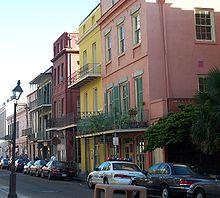
According to the 2010 Census, 343,829 people and 189,896 households were in New Orleans. The racial and ethnic makeup of the city was 60.2% African American, 33.0% White, 2.9% Asian (1.7% Vietnamese, 0.3% Indian, 0.3% Chinese, 0.1% Filipino, 0.1% Korean), 0.0% Pacific Islander, and 1.7% were people of two or more races. People of Hispanic or Latino origin made up 5.3% of the population; 1.3% of New Orleans is Mexican, 1.3% Honduran, 0.4% Cuban, 0.3% Puerto Rican, and 0.3% Nicaraguan.[105]
The last population estimate before Hurricane Katrina was 454,865, as of July 1, 2005.[106] A population analysis released in August 2007 estimated the population to be 273,000, 60% of the pre-Katrina population and an increase of about 50,000 since July 2006.[107] A September 2007 report by The Greater New Orleans Community Data Center, which tracks population based on U.S. Postal Service figures, found that in August 2007, just over 137,000 households received mail. That compares with about 198,000 households in July 2005, representing about 70% of pre-Katrina population.[108] More recently, the Census Bureau revised upward its 2008 population estimate for the city, to 336,644 inhabitants. In 2010, estimates showed that neighborhoods that did not flood were near 100% of their pre-Katrina populations, and in some cases, exceeded 100% of their pre-Katrina populations.
A 2006 study by researchers at Tulane University and the University of California, Berkeley determined that there are as many as 10,000 to 14,000 illegal immigrants, many from Mexico, currently residing in New Orleans.[109] Janet MurguRa, president and chief executive officer of the National Council of La Raza, stated that there could be up to 120,000 Hispanic workers in New Orleans. In June 2007, one study stated that the Hispanic population had risen from 15,000, pre-Katrina, to over 50,000.[110]
A recent article released by The Times-Picayune indicated that the metropolitan area had undergone a recent influx of 5,300 households in the later half of 2008, bringing the population to around 469,605 households or 88.1% of its pre-Katrina levels. While the area's population has been on an upward trajectory since the storm, much of that growth was attributed to residents returning after Katrina. Many observers predicted that growth would taper off, but the data center's analysis suggests that New Orleans and the surrounding parishes are benefiting from an economic migration resulting from the global financial crisis of 2008 ae2009.[111][112]
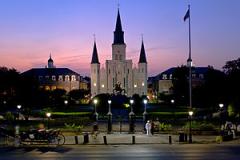
New Orleans is notably absent from the Protestant Bible Belt that dominates religion in the Southern United States. In New Orleans and the surrounding Louisiana Gulf Coast area, the predominant religion is Catholicism. Within the Archdiocese of New Orleans (which includes not only the city but the surrounding Parishes as well), 35.9% percent of the population is Roman Catholic.[113] The influence of Catholicism is reflected in many of the city's French and Spanish cultural traditions, including its many parochial schools, street names, architecture, and festivals, including Mardi Gras.
New Orleans also famously has a presence of its distinctive variety of Louisiana Voodoo, due in part to syncretism with Roman Catholic beliefs, the fame of voodoo practitioner Marie Laveau, and New Orleans' distinctly Caribbean cultural influences.[114][115][116] Although the exotic image of Voodoo within the city has been highly promoted by the tourism industry, there are only a small number of serious adherents to the religion.
New Orleans' pre-Katrina population of 10,000 Jews has now dropped to 7,000. In the wake of Katrina, all New Orleans synagogues lost members, but were able to re-open in their original locations, except for Congregation Beth Israel, the oldest and most prominent Orthodox synagogue in the New Orleans region. Beth Israel's building in Lakeview was destroyed by flooding, and it is currently in temporary quarters in Metairie.[117]

New Orleans has a mayor-council government. The city council consists of seven council members, who are elected by district and two at-large councilmembers. The current mayor, Mitch Landrieu, was elected on February 6, 2010 and assumed office on May 3, 2010.[118][119] The Orleans Parish Civil Sheriff's Office serves papers involving lawsuits and provides security for the Civil District Court and Juvenile Courts. The Criminal Sheriff, Marlin Gusman, maintains the parish prison system, provides security for the Criminal District Court, and provides backup for the New Orleans Police Department on an as-needed basis.
The city of New Orleans and the parish of Orleans operate as a merged city-parish government.[120] Before the city of New Orleans became co-extensive with Orleans Parish, Orleans Parish was home to numerous smaller communities. The original city of New Orleans was composed of what are now the 1st through 9th wards. The city of Lafayette (including the Garden District) was added in 1852 as the 10th and 11th wards. In 1870, Jefferson City, including Faubourg Bouligny and much of the Audubon and University areas, was annexed as the 12th, 13th, and 14th wards. Algiers, on the west bank of the Mississippi, was also annexed in 1870, becoming the 15th ward.
New Orleans' government is now largely centralized in the city council and mayor's office, but it maintains a number of relics from earlier systems when various sections of the city ran much of their affairs separately. For example, New Orleans has seven elected tax assessors, each with their own staff, representing various districts of the city, rather than one centralized office. A constitutional amendment passed on November 7, 2006, will consolidate the seven assessors into one by 2010. On February 18, 2010, Errol Williams was elected as the first city-wide assessor.[121] The New Orleans government operates both a fire department and the New Orleans Emergency Medical Services.
The United States Postal Service operates post offices in New Orleans. The New Orleans Main Post Office is at 701 Loyola Avenue in the Central Business District.[122]
Crime has been recognized as an ongoing problem for New Orleans, although the issue is outside the view of most visitors to the city: as in other cities in the United States of comparable size, the incidence of homicide and other violent crimes is highly concentrated in certain impoverished neighborhoods, such as housing projects.[123]
Across New Orleans, homicides peaked in 1994 at 86 murders per 100,000 residents.[124] By 2009, despite a 17% decrease in violent crime in the city, the homicide rate remained among the highest[125] in the United States, at between 55 and 64 per 100,000 residents.[126] In 2010, New Orleans was 49.1 per 100,000.[127] This is the highest rate among cities of 250,000 population or larger.[128] Offenders in New Orleans are almost exclusively black men, with 97% of the offenders being black and 95% being male.[129]
The violent crime rate was also a key issue in the city's 2010 mayoral race. In January 2007, several thousand New Orleans residents marched through city streets and gathered at City Hall for a rally demanding police and city leaders tackle the crime problem. Mayor Ray Nagin said he was "totally and solely focused" on addressing the problem. Later, the city implemented checkpoints during late night hours in problem areas.[130]
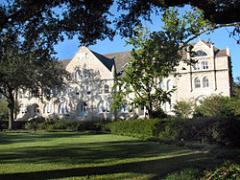
There are several higher education institutions in the city:
New Orleans Public Schools (NOPS) is the name given to the city's public school system. Pre-Katrina, NOPS was one of the area's largest systems (along with the Jefferson Parish public school system). In the years leading up to Hurricane Katrina, the New Orleans public school system was widely recognized as the lowest performing school district in Louisiana. According to researchers Carl L. Bankston and Stephen J. Caldas, only 12 of the 103 public schools within the city limits of New Orleans showed reasonably good performance at the beginning of the 21st century.[131]
Following Hurricane Katrina, the state of Louisiana took over most of the schools within the system (all schools that fell into a nominal "worst-performing" metric); many of these schools, in addition to others that were not subject to state takeover, were subsequently granted operating charters giving them administrative independence from the Orleans Parish School Board, the Recovery School District and/or the Louisiana Board of Elementary and Secondary Education (BESE). Presently, the majority of public school students in the NOPS system attend these independent public charter schools, the highest percentage in the nation.[132]
The last few years have witnessed significant and sustained gains in student achievement, as outside operators like KIPP, the Algiers Charter School Network, and the Capital One ae University of New Orleans Charter School Network have assumed control of dozens of schools. The most recent release of annual school performance scores (October 2009) demonstrated continued growth in the academic performance of New Orleans' public schools. If the scores of all public schools in New Orleans (Orleans Parish School Board-chartered, Recovery School District-chartered, Recovery School District-operated, etc.) are considered, an overall school district performance score of 70.6 results. This score represents a 6% increase over an equivalent 2008 metric, and a 24% improvement when measured against an equivalent pre-Katrina (2004) metric, when a district score of 56.9 was posted.[133] Notably, this score of 70.6 approaches the score (78.4) posted in 2009 by the adjacent, suburban Jefferson Parish public school system, though that system's performance score is itself below the state average of 91.[134]
This longstanding pattern is changing, however, as the NOPS system is engaged in the most promising and far-reaching public school reforms in the nation, reforms aimed at decentralizing power away from the pre-Katrina school board central bureaucracy to individual school principals and independent public charter school boards, monitoring charter school performance by granting renewable, five-year operating contracts permitting the closure of those not succeeding, and vesting choice in parents of public schools students, allowing them to enroll their children in almost any school in the district.[135]
There are numerous academic and public libraries and archives in New Orleans, including Monroe Library at Loyola University, Howard-Tilton Memorial Library at Tulane University,[136] the Law Library of Louisiana,[137] and the Earl K. Long Library at the University of New Orleans.[138]
The New Orleans Public Library includes 13 locations, most of which were damaged by Hurricane Katrina. However, only four libraries remained closed in 2007.[139] The main library includes a Louisiana Division housing city archives and special collections.[140]
Other research archives are located at the Historic New Orleans Collection[141] and the Old U.S. Mint.[142]
An independently operated lending library called Iron Rail Book Collective specializes in radical and hard-to-find books. The library contains over 8,000 titles and is open to the public. It was the first library in the city to re-open after Hurricane Katrina.
The Louisiana Historical Association was founded in New Orleans in 1889. It operated first at Howard Memorial Library. Then its own Memorial Hall was added to Howard Library. The design for the new building was undertaken by the New Orleans architect Thomas Sully.[143]
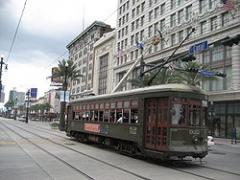
New Orleans has three active streetcar lines. The St. Charles line is the oldest continuously operating streetcar line in America and each car is a historic landmark. The Riverfront line runs parallel to the river from Esplanade Street through the French Quarter to Canal Street to the Convention Center above Julia Street in the Arts District. The Canal Street line uses the Riverfront line tracks from the intersection of Canal Street and Poydras Street, down Canal Street, then branches off and ends at the cemeteries at City Park Avenue, with a spur running from the intersection of Canal and Carrollton Avenue to the entrance of City Park at Esplanade, near the entrance to the New Orleans Museum of Art.
The city's streetcars were also featured in the Tennessee Williams play, A Streetcar Named Desire. The streetcar line to Desire Street became a bus line in 1948. There are proposals to revive a Desire streetcar line, running along the neutral grounds of North Rampart and St. Claude, as far downriver as Poland Avenue, near the Industrial Canal.
Hurricane Katrina destroyed the power lines supplying the St. Charles Avenue line. The associated levee failures flooded the Mid-City facility storing the red streetcars which normally run on the Riverfront and Canal Street lines. Restoration of service has been gradual, with vintage St. Charles line cars running on the Riverfront and Canal lines until the more modern Czech-built red cars are back in service; they are being individually restored at the RTA's facility in the Carrollton neighborhood. On December 23, 2007, streetcars were restored to running on the St. Charles line up to Carrolton Avenue. The much-anticipated re-opening of the second portion of the historic route, which continues until the intersection of Carrolton Avenue and Claiborne Avenue, was commemorated on June 28, 2008.[144]
The city's flat landscape, simple street grid, and mild winters, facilitate bicycle ridership, helping to make New Orleans 8th among U.S. cities in its rate of bicycle and pedestrian transportation,[145] and 6th in terms of the percentage of bicycling commuters.[146] Also, the City's bicyclists benefit from being located at the start of the Mississippi River Trail, a 3,000-mile (4,800 km) bicycle path that stretches from the City's Audubon Park to Minnesota.[147] The first 25 miles (40 km) of the path, through Destrehan, Louisiana, is paved with a smooth macadam surface. Bicyclists looking to cross the River have free access to the City's ferries.[148] Since the 2005 levee-breach, the City has actively sought to promote bicycling by constructing a $1.5 million bike trail from Mid-City to Lake Pontchartrain,[149] and by adding over 37 miles (60 km) of bicycle lanes to various streets, including St. Charles Avenue.[145] In 2009, Tulane University contributed to these efforts by converting the main street through its Uptown campus, McAlister Place, into a pedestrian mall opened to bicycle traffic.[150] In 2010, work began to add a 3.1-mile (5 km) bicycle corridor from the French Quarter to Lakeview, and 14 miles (23 km) of additional bike lanes on existing streets.[146] New Orleans has also been recognized as a place with an abundance of uniquely decorated and uniquely designed bicycles.[151][152]
Public transportation in the city is operated by the New Orleans Regional Transit Authority ("RTA"). There are many bus routes connecting the city and suburban areas. The RTA lost 200+ buses due to Hurricane Katrina, this would mean that there would be a 30 ae60 minute waiting period for the next bus to come to the bus stop, and the streetcars took until 2008 to return, so the RTA placed an order for 38 Orion VII Next Generation clean diesel buses, which arrived in July 2008. The RTA has these new buses running on biodiesel. The Jefferson Parish Department of Transit Administration[153] operates Jefferson Transit, which provides service between the city and its suburbs.[154]
New Orleans is served by Interstate 10, Interstate 610 and Interstate 510. I-10 travels east-west through the city as the Pontchartrain Expressway. In the far eastern part of the city, New Orleans East, it is known as the Eastern Expressway. I-610 provides a direct shortcut for traffic passing through New Orleans via I-10, allowing that traffic to bypass I-10's southward curve. In the future, New Orleans will have another interstate highway, Interstate 49, which will be extended from its current terminus in Lafayette to the city.
In addition to the interstate highways, U.S. 90 travels through the city, while U.S. 61 terminates in the city's downtown center. In addition, U.S. 11 terminates in the eastern portion of the city.
New Orleans is home to many bridges, the tolled Crescent City Connection is perhaps the most notable. It serves as New Orleans' major bridge across the Mississippi River, providing a connection between the city's downtown on the eastbank and its westbank suburbs. Other bridges that cross the Mississippi River in the New Orleans area are the Huey P. Long Bridge, over which U.S. 90 travels, and the Hale Boggs Memorial Bridge, which carries Interstate 310.
The Twin Span Bridge, a five-mile (8 km) causeway in eastern New Orleans, carries I-10 across Lake Pontchartrain. Also in eastern New Orleans, Interstate 510/LA 47 travels across the Intracoastal Waterway/Mississippi River-Gulf Outlet Canal via the Paris Road Bridge, connecting New Orleans East and suburban Chalmette.
The tolled Lake Pontchartrain Causeway, consisting of two parallel bridges are, at 24 miles (39 km) long, the longest bridges in the world. Built in the 1950s (southbound span) and 1960s (northbound span), the bridges connect New Orleans with its suburbs on the north shore of Lake Pontchartrain via Metairie.
The metropolitan area is served by the Louis Armstrong New Orleans International Airport, located in the suburb of Kenner. New Orleans also has several regional airports located throughout the metropolitan area. These include the Lakefront Airport, Naval Air Station Joint Reserve Base New Orleans (locally known as Callendar Field) in the suburb of Belle Chasse and "Southern Seaplane", also located in Belle Chasse. Southern Seaplane has a 3,200-foot (980 m) runway for wheeled planes and a 5,000-foot (1,500 m) water runway for seaplanes. New Orleans International suffered some damage as a result of Hurricane Katrina, but as of April 2007, it contained the most traffic and is the busiest airport in the state of Louisiana and the sixth busiest in the Southeast.
The city is served by rail via Amtrak. The New Orleans Union Passenger Terminal is the central rail depot, and is served by three trains: the Crescent, operating between New Orleans and New York City; the City of New Orleans, operating between New Orleans and Chicago; and the Sunset Limited, operating through New Orleans between Orlando and Los Angeles. From late August 2005 to the present, the Sunset Limited has remained officially an Orlando-to-Los Angeles train, being considered temporarily truncated due to the lingering effects of Hurricane Katrina. At first (until late October 2005) it was truncated to a San Antonio-to-Los Angeles service; since then (from late October 2005 on) it has been truncated to a New Orleans-to-Los Angeles service. As time has passed, particularly since the January 2006 completion of the rebuilding of damaged tracks east of New Orleans by their owner, CSX Transportation, the obstacles to restoration of the Sunset Limited's full route have been more managerial and political than physical.
With the strategic benefits of both a major international port and one of the few double-track Mississippi River crossings, the city is served by six of the seven Class I railroads in North America: Union Pacific Railroad, BNSF Railway, Norfolk Southern Railway, Kansas City Southern Railway, CSX Transportation and Canadian National Railway. The New Orleans Public Belt Railroad provides interchange services between the railroads.
Recently, many have proposed extending New Orleans' public transit system by adding light rail routes from downtown, along Airline Highway through the airport to Baton Rouge and from downtown to Slidell and the Mississippi Gulf Coast. Proponents of this idea claim that these new routes would boost the region's economy, which has been badly damaged by Hurricane Katrina, and serve as an evacuation option for hospital patients out of the city.[155]
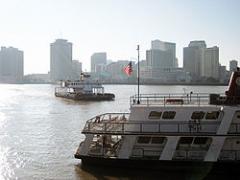
The Canal Street Ferry connects the heart of New Orleans with the neighborhood of Algiers Point on the other side of the Mississippi River. The Canal Street/Gretna Ferry services Gretna, Louisiana through a separate route.[148] This service has been in continuous operation since 1827 and runs from 6 am until midnight. The Gretna Ferry is free in both directions, although it serves pedestrians and bicyclists only.
The Algiers Ferry services passenger vehicles, bicycles and pedestrians; cyclists and pedestrians ride the for free in both directions. Vehicles are free from Canal Street to Algiers, but there is a $1 fee when traveling from Algiers to Canal Street.
New Orleans has ten sister cities:[156]
The city's several nicknames are illustrative:
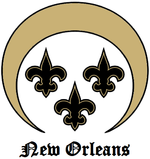

Word Count: 11889





